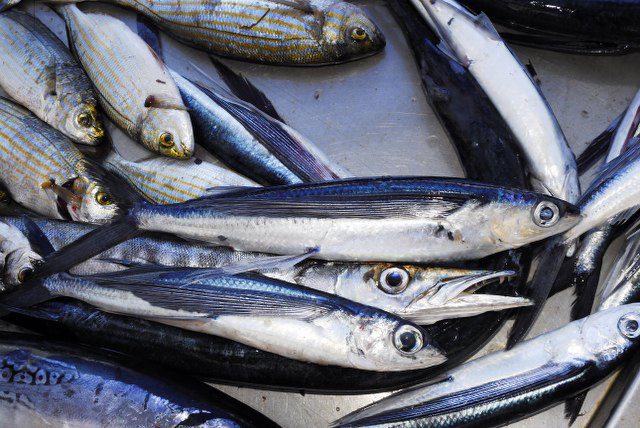Cheilopogon
heterurus
(Rafinesque,
1810)
Mediterranean flyingfish
View all media / Upload your photos and videos
Expand all
Classification / Names
Teleostei (teleosts) > Beloniformes (Needle fishes) >
Exocoetidae (Flyingfishes)
Etymology: Cheilopogon: Greek, cheilos = lip + Greek, pogon = barbed, beard (Ref. 45335).
More on author:
Rafinesque.
Environment / milieu / depth range / climate zone / distribution range
Marine; pelagic-neritic; oceanodromous (Ref. 51243); depth range 0 - 50 m; subtropical; 59°N - 30°N65°W - 16°E.
Distribution
Eastern Atlantic: southern Norway and Denmark (rare) to Gibraltar and western Mediterranean. Western Atlantic: around Bermuda (Ref. 26938). Eastern Indian Ocean: Western Australia (Ref. 49596) and Victoria, Australia (Ref. 33839). Also throughout subtropical waters of the Pacific Ocean (Ref. 33839).
Maps

Cheilopogon heterurus / Native range
AquaMaps Data sources:
GBIF
OBIS
This map was computer-generated and has not yet been reviewed.

Cheilopogon heterurus / Suitable habitat
AquaMaps Data sources:
GBIF
OBIS
This map was computer-generated and has not yet been reviewed.

Cheilopogon heterurus / Point map
AquaMaps Data sources:
GBIF
OBIS
This map was computer-generated and has not yet been reviewed.

Cheilopogon heterurus / Year 2050
AquaMaps Data sources:
GBIF
OBIS
This map was computer-generated and has not yet been reviewed.
Size / Weight / Age
Biology
Pelagic, coastal species which can fly over long distances. It is thought that this behavior is a means to escape danger. This flying fish is not commercially exploited although it is very good to eat (Ref. 5377). Spawns during summer in Italian waters. Eggs with filaments over the entire surface (Ref. 6523).
Main reference
Bauchot, M.-L. 1987 Poissons osseux. p. 891-1421. In W. Fischer, M.L. Bauchot and M. Schneider (eds.) Fiches FAO d'identification pour les besoins de la pêche. (rev. 1). Méditerranée et mer Noire. Zone de pêche 37. Vol. II. Commission des Communautés Européennes and FAO, Rome. (Ref. 3397)
IUCN Red List Status (Ref. 125652)
Least Concern (LC); date assessed: January 28 2013
CITES (Ref. 131153)
Not Evaluated
CMS (Ref. 116361)
Not Evaluated
Threat to humans
Harmless
More information
- Countries
- FAO areas
- Ecosystems
- Occurrences
- Introductions
- Stocks
- Ecology
- Diet
- Food items
- Food consumption
- Ration
- Common names
- Synonyms
- Metabolism
- Predators
- Ecotoxicology
- Reproduction
- Maturity
- Spawning
- Spawning aggregation
- Fecundity
- Eggs
- Egg development
- Age/Size
- Growth
- Length-weight
- Length-length
- Length-frequencies
- Morphometrics
- Morphology
- Larvae
- Larval dynamics
- Recruitment
- Abundance
- References
- Aquaculture
- Aquaculture profile
- Strains
- Genetics
- Allele frequencies
- Heritability
- Diseases
- Processing
- Mass conversion
- Vision
- Pictures
- Stamps, Coins Misc.
- Sounds
- Ciguatera
- Speed
- Swim. type
- Gill area
- Otoliths
- Brains
Estimates based on models
Preferred temperature (Ref. 123201): 11.8 - 21, mean 17.5 °C (based on 140 cells).
Phylogenetic diversity index (Ref. 82804): PD50 = 0.5 [Uniqueness, from 0.5 = low to 2.0 = high].
Bayesian length-weight: a=0.00631 (0.00288 - 0.01384), b=3.05 (2.85 - 3.25), in cm total length, based on LWR estimates for this (Sub)family-body shape (Ref. 93245).
Trophic level (Ref. 69278): 3.4 ±0.5 se; Based on food items.
Resilience (Ref. 120179): High, minimum population doubling time less than 15 months (Preliminary K or Fecundity.).
Fishing vulnerability (Ref. 59153): Low to moderate vulnerability (30 of 100).
Price category (Ref. 80766): Medium; Very questionable: based on ex-vessel price for species in this family.
Nutrients (Ref. 124155): Calcium = 208 [75, 435] mg/100g; Iron = 1.75 [0.86, 3.98] mg/100g; Protein = 17.7 [15.6, 19.6] %; Omega3 = 0.344 [0.159, 0.953] g/100g; Selenium = 25.9 [11.7, 54.0] μg/100g; VitaminA = 15.3 [4.6, 59.1] μg/100g; Zinc = 0.83 [0.57, 1.25] mg/100g (wet weight);

